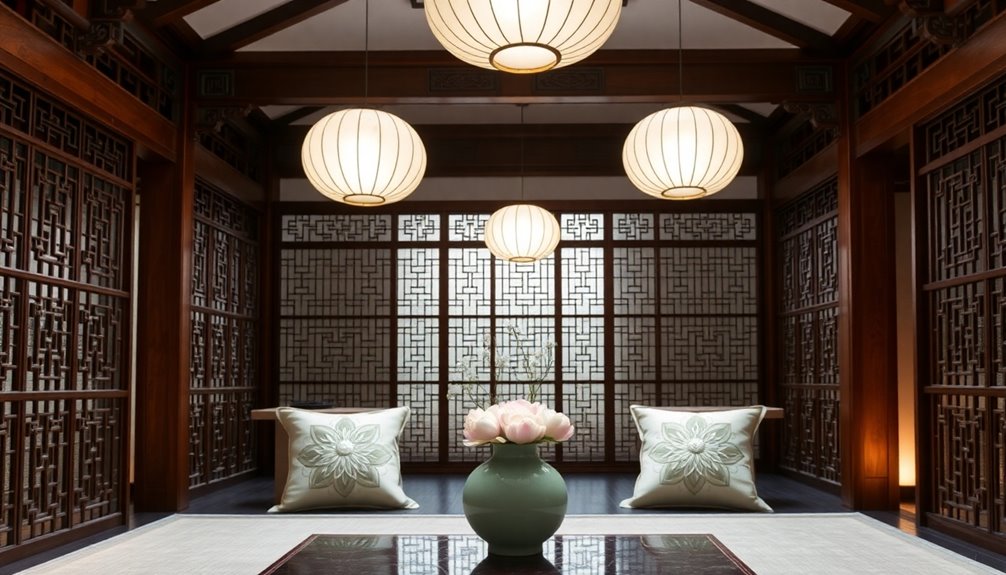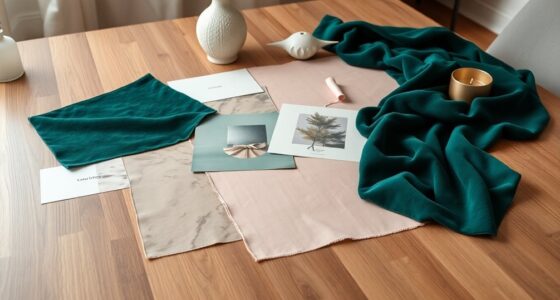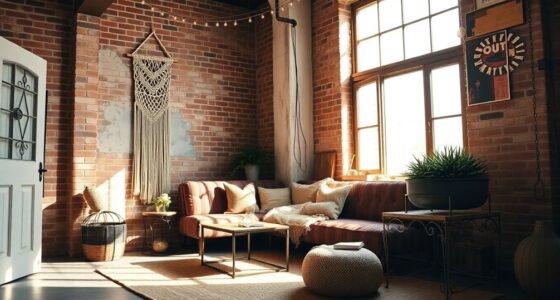Chinese interior design captures a rich blend of tradition and elegance that you can easily appreciate. It reflects deep-rooted philosophies like Confucianism and Feng Shui, guiding the flow of energy in a space. You'll notice vibrant colors like red and gold, symbolizing prosperity, alongside intricate wooden furniture that showcases fine craftsmanship. Designs often incorporate natural materials, enhancing harmony with nature. Architectural elements like upturned eaves and lattice work add beauty and functionality. Plus, decorative accessories like porcelain vases and silk lanterns enrich the aesthetic. You'll uncover even more layers of this thoughtful design approach as you explore further.
Key Takeaways
- Chinese interior design emphasizes harmony and balance, integrating Feng Shui principles to optimize energy flow within spaces.
- Traditional elements include natural materials like wood and silk, showcasing craftsmanship and a connection to nature.
- The use of a dominant color palette featuring red, gold, and black symbolizes prosperity, luck, and social status.
- Furniture often features low profiles and intricate carvings, promoting intimacy and social interaction while reflecting historical styles.
- Decorative accessories, such as porcelain vases and calligraphy, enhance aesthetics and cultural richness within the interior space.
Historical Context
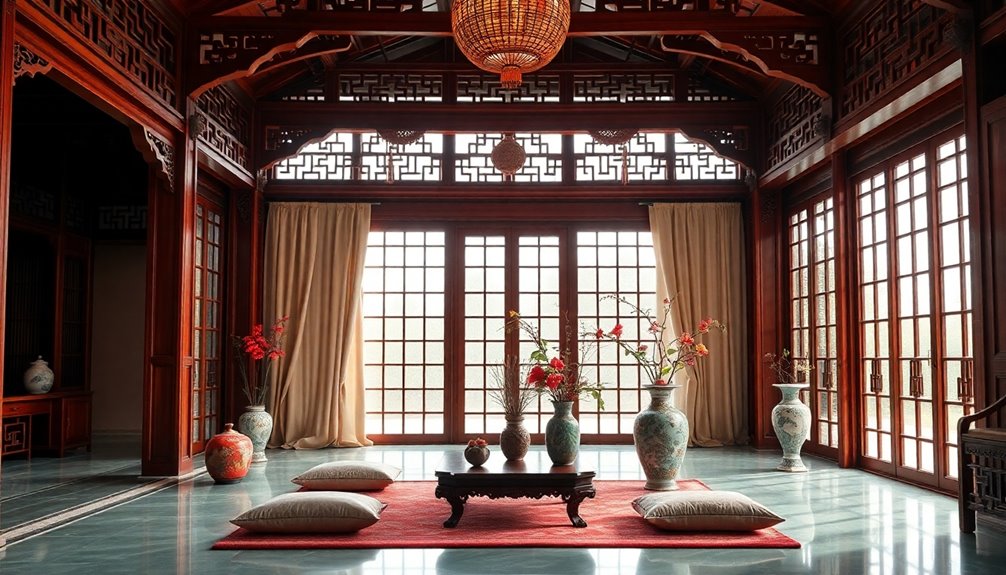
Historically, Chinese interior design reflects a deep connection to cultural philosophies and social structures. It's rooted in the ancient dynasties, where principles from Confucianism, Taoism, and Buddhism emphasized harmony and balance in living spaces.
Throughout the historical context, design styles evolved, showcasing simplicity in the Han Dynasty and ornate aesthetics during the Ming and Qing Dynasties. Feng Shui plays a crucial role, guiding the arrangement of spaces to optimize the flow of Qi.
Traditional designs often employed natural materials like wood, silk, and ceramics, highlighting superior craftsmanship. Moreover, color palettes and decorative motifs conveyed social status and wealth, with red symbolizing prosperity and auspicious meanings.
This rich history continues to influence modern interpretations of Chinese interior design.
Key Design Elements
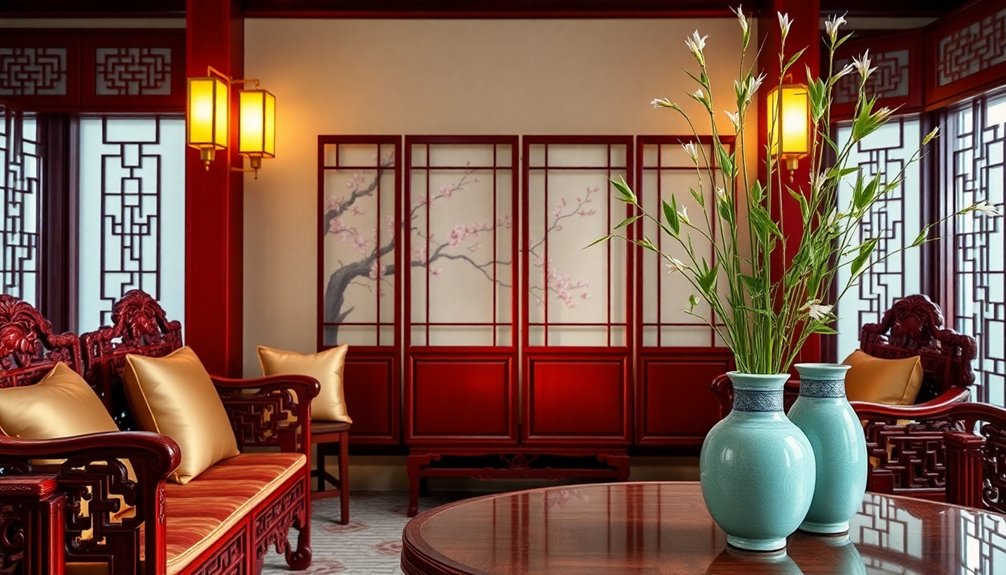
Chinese interior design is marked by distinctive key elements that embody its cultural heritage and aesthetic values.
You'll notice a striking color palette dominated by red, gold, and black, symbolizing prosperity, luck, and elegance. The furniture often features low profiles and intricate carvings, showcasing the craftsmanship of traditional artisans while promoting intimacy in your space.
Decorative elements like folding screens and intricate wood latticework not only enhance privacy but also add artistic flair. You'll find an emphasis on natural materials such as wood, silk, and ceramics, reflecting a deep connection to nature.
Additionally, Feng Shui principles guide the arrangement of furniture and decor, ensuring optimal energy flow and balance throughout your living area.
Architectural Features
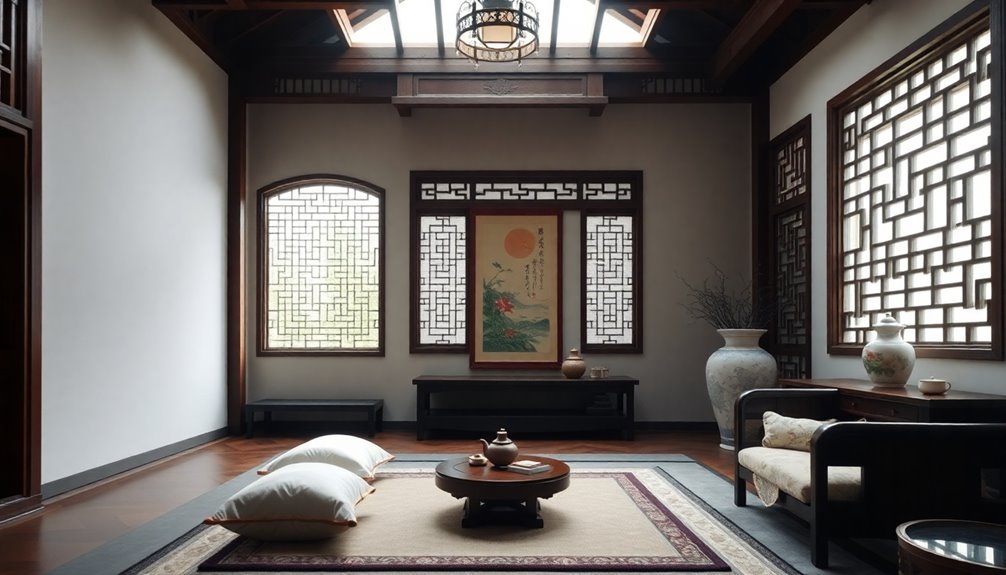
When exploring architectural features, you'll find that traditional designs prioritize symmetry and axial alignment, often centering around a courtyard that invites communal gatherings.
The upturned eaves of roofs not only enhance aesthetic appeal but also help rainwater drain away from the foundation.
You'll notice intricate woodwork and carvings that showcase the craftsmanship of various dynastic periods.
Lattice windows adorned with decorative designs allow natural light to filter in while maintaining privacy and a connection to the outdoors.
Using natural materials like wood and stone promotes harmony with the environment, creating an overall aesthetic balance in the space.
Each element contributes to a cohesive design that reflects the elegance and richness of Chinese architectural heritage.
Furniture Styles and Arrangement
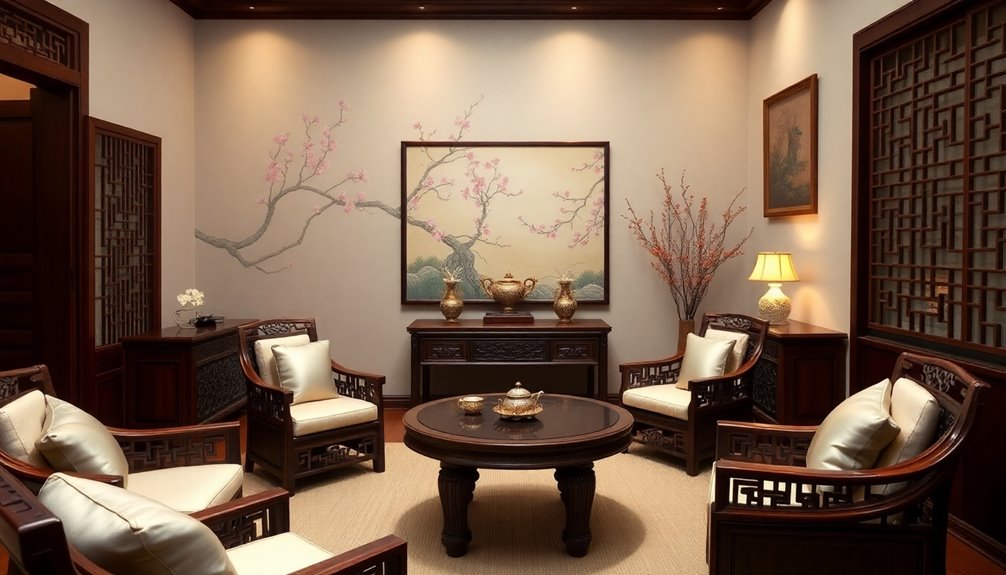
The elegance of Chinese interior design continues with its distinctive furniture styles and arrangements.
Chinese furniture styles, especially from the Ming and Qing Dynasties, showcase a harmony of simplicity and elaborate craftsmanship. Ming Dynasty pieces are known for clean lines and high-quality hardwoods, while Qing furniture features intricate carvings and decorative elements.
Arranging furniture according to Feng Shui principles enhances seating positions that promote relaxation and optimal Qi flow. You'll often find low-to-the-ground furniture, fostering an intimate atmosphere for social interaction.
Key items like wedding cabinets, adorned with elaborate carvings that symbolize auspicious meanings, elevate your interior appeal. Together, these elements create a cohesive and inviting space that reflects both tradition and elegance.
Decorative Accessories

Decorative accessories play a crucial role in enhancing the beauty and cultural depth of your interior space. Incorporating intricate porcelain vases and bowls adds vibrant colors and showcases exceptional craftsmanship, reflecting their cultural significance.
Calligraphy and traditional paintings serve as stunning wall art, featuring themes that enrich your decor with depth. Folding screens not only act as functional room dividers but also enhance aesthetics with their beautifully adorned murals.
Silk lanterns provide ambient lighting while serving as decorative focal points, creating a warm and inviting atmosphere. Lastly, jade artifacts, often carved into meaningful shapes, add an auspicious touch to your home, believed to bring good luck and prosperity.
Together, these decorative accessories create a harmonious blend of tradition and elegance.
Modern Adaptations
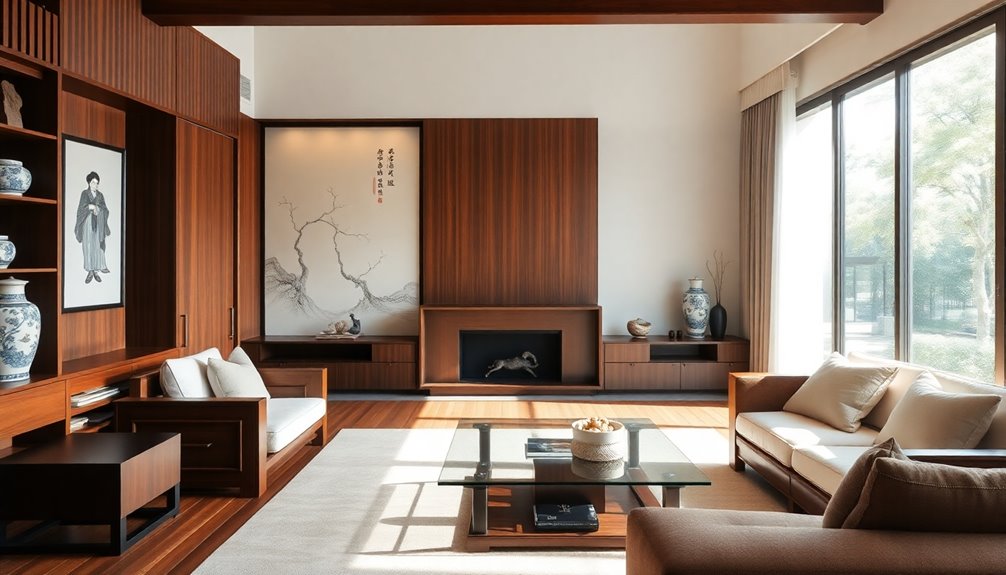
Incorporating decorative accessories sets the stage for modern adaptations in Chinese interior design.
You'll find that minimalist aesthetics beautifully highlight traditional artifacts, creating a balance between contemporary simplicity and cultural richness.
Sustainable materials like bamboo and reclaimed wood are popular, reflecting eco-conscious trends while maintaining the integrity of traditional design.
Modern spaces often feature smart home systems, enhancing functionality without overshadowing traditional elements.
You'll also notice hybrid styles that fuse traditional motifs with global influences, appealing to a diverse clientele.
Cultural Significance
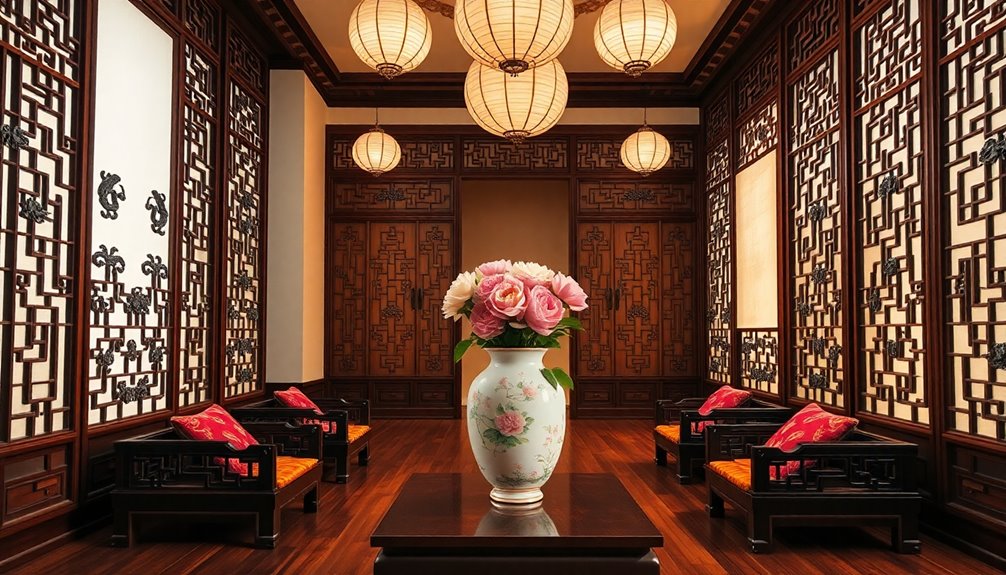
Understanding the cultural significance of Chinese interior design reveals how deeply it intertwines with values like prosperity and luck.
You'll notice that decorative motifs, such as dragons and phoenixes, embody rich symbolism, enhancing the narrative of your space. By incorporating auspicious colors like red for fortune and gold for wealth, you reflect essential cultural values that elevate social status and identity.
Festivals and rituals often dictate your decorative choices, ensuring that your interiors align with customs and amplify social gatherings.
Additionally, appreciating traditional craftsmanship preserves heritage, making your home not just aesthetically beautiful but also a vessel of history.
Ultimately, Chinese interior design celebrates a harmonious blend of elegance and cultural richness that resonates deeply within each choice you make.
Practical Feng Shui Applications
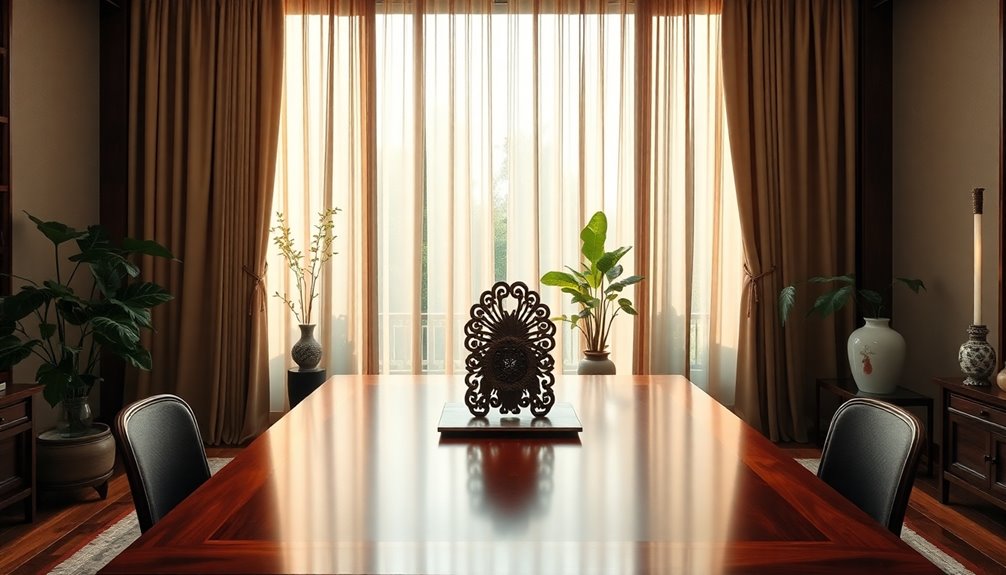
Recognizing the cultural significance of Chinese interior design naturally leads you to practical Feng Shui applications that enhance your living space's energy.
Start by decluttering your areas to improve energy circulation; a cluttered space can obstruct the flow of Qi and create stress.
Use mirrors strategically to reflect light and energy, making your rooms feel brighter and more spacious.
Incorporate plants to symbolize growth and vitality, while also purifying the air for a balanced environment.
Pay attention to furniture arrangement, ensuring seating faces the entrance for a sense of security.
Lastly, utilize color symbolism; reds attract good fortune, while blues and greens promote calmness and serenity, creating a harmonious atmosphere in your home.
Frequently Asked Questions
What Are the Elements of Chinese Interior Design?
When you think about the elements of Chinese interior design, natural materials like wood and bamboo immediately come to mind.
You'll notice a color palette featuring reds, golds, and blacks, each symbolizing luck, wealth, and sophistication.
Feng Shui principles guide the layout, enhancing balance and harmony.
Intricately carved furniture and decorative screens showcase craftsmanship, while incorporating plants and water features creates a serene atmosphere.
These elements together form a tranquil and inviting space.
What Are the Elements of Traditional Chinese Design?
When you explore traditional Chinese design, you'll notice its emphasis on balance and harmony.
You'll find rich colors like deep reds and golds, symbolizing prosperity.
Furniture is often low to promote intimacy, showcasing intricate carvings from the Ming and Qing dynasties.
Decorative elements like folding screens enhance both function and aesthetics, while natural materials connect you with nature.
Incorporating plants and water features creates a serene environment that fosters tranquility.
What Is the Chinese Concept Related to Interior Design?
Imagine walking into a space where every corner harmonizes like a perfectly tuned orchestra.
The Chinese concept of interior design revolves around creating balance and harmony through Feng Shui, which promotes positive energy flow.
You'll notice the interplay of Yin and Yang, ensuring contrasting elements coexist beautifully.
The Five Elements Theory guides your choices in colors and materials, while natural materials connect you with nature, fostering an elegant, tranquil atmosphere in your surroundings.
What Is Chinese Interior Design Style Called?
The Chinese interior design style is often referred to as "Chinese Classical" or "Traditional Chinese" design.
This style emphasizes harmony and balance while connecting with nature. You'll notice features like intricate wood carvings and rich color schemes that symbolize luck and prosperity.
If you're looking to create a space that reflects these principles, you might want to explore both traditional elements and contemporary adaptations, blending them for a modern take on this classic aesthetic.
Conclusion
As you step into a space adorned with Chinese interior design, it feels like entering a serene garden where tradition blossoms amidst modernity's embrace. Each element tells a story, weaving together the past and present in a harmonious dance. Just as a river flows gracefully through ancient landscapes, this style invites you to experience elegance and balance in your own home. Embracing these characteristics isn't just decorating; it's nurturing a living tapestry of culture and tranquility.
